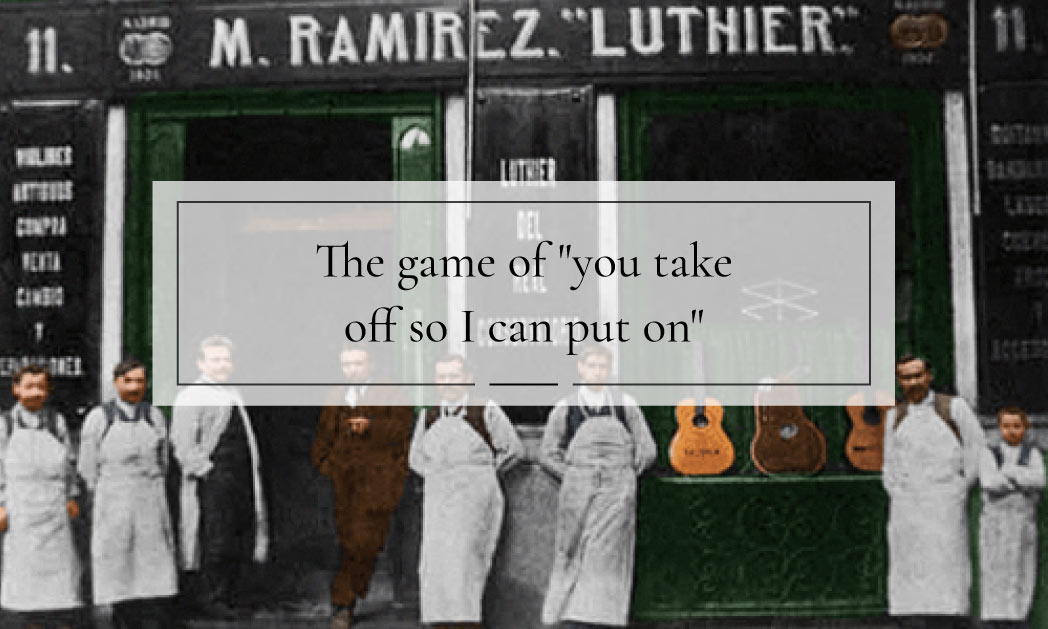Since the word spread regarding Santos Hernández’s claim that he had been the creator of the Manuel Ramírez guitar that Manuel gave to Andrés Segovia (which is currently on display at the Metropolitan Museum of Fine Art in New York) there has been a work of harassment and demolition of the image of Manuel Ramírez to put his disciple and official Santos Hernández in his place.
And since then, there has been less talk about the work of Manuel Ramírez and more about his workshop, as if they were dissociated elements. The boldest even ignore Manuel Ramírez directly, mentioning only Santos Hernández when referring to the aforementioned guitar.
Recognising the work of the master
It is obvious that Santos Hernández did not feel any respect or gratitude towards his master and employer Manuel Ramírez, which is the least that is owed to the one who has taught him his trade, his secrets, his way of working, and the fruits of his experience. But that is the least important thing, the most important thing is that there are others who give credibility to the word of someone who claims an authorship that does not correspond to him, because to speak frankly, who is the author of a work? Is it not the one who designed it, after training and researching and making an investment in its development? Or his employees, who help him do the work following his designs, instructions, and teachings, using his material and his studio?
I’ve even had to hear from an “expert” that Santos Hernández’s hand can be seen on that guitar (who also assures that it is originally an 11-string guitar, when in reality it was a 7-string, adapted to 6 strings, for which it would suffice to see the photograph of the back of the head, published by the MET)*.
Of course, Santos worked with Manuel Ramírez and learned his techniques, those used, logically, in his workshop, so the hand of the other two great officials of Manuel, Modesto Borreguero (1892-1969) and Domingo Esteso (1882-1937) could be recognized in the guitars built in that workshop, but above all, the hand of Manuel Ramírez, creator of his work.
We have always recognized and respected our maestro Francisco González (1820-1879), as I wrote in another article in homage to the maestro, and we have never even thought to say that one of his guitars was built by José Ramírez I (1858-1923), because José did not make his own guitars until he became independent. He then developed his own designs and templates, such as the well-known Tablao Guitar, which revolutionized the world of flamenco at the time, and which his brother and outstanding disciple Manuel would later take to transform it and lay the foundations of the current flamenco guitar.
Proofs of the authorship of Andrés Segovia’s guitar
On the other hand, even admitting that the fact that an official made a guitar in his master’s workshop could have some value, what solid document supports Santos Hernández’s statement about his authorship of that guitar? There is nothing but his word, which, by the way, is not even supported by the reality of the traditional operation of artisan workshops, nor of art workshops, nor of the most elementary ethics.
It has never been said that a Guarneri (1698-1744) violin was “from Guarneri’s workshop”. And the Sagrada Familia of Gaudí (1852-1926) is still his work, still under construction despite the fact that its author died a century ago. But in the world of guitar making it seems that some believe that we do not deserve the category of other great and renowned creators whose authorship of their work is not questioned.
Here one would have to ask why, since the claim that this guitar was the work of Santos Hernández began to spread, did his guitars begin to reach such high prices in the market? What interest is there in putting Santos Hernández eclipsing Manuel Ramírez? Of course, if “his” guitar was the first to accompany Segovia in his brilliant career and it is also at the MET, what better publicity for Santos? But why? What advantages can it bring to someone who died a long time ago and without descendants or disciples? Who benefits then? Certainly, it is not the same when it comes to someone, also deceased, with a recognized name and prestige who has living descendants active in the trade.
Manuel Ramirez’s label
We know that Santos Hernández wanted to replace Manuel Ramírez’s label with one of his own, when Andrés Segovia brought him Manuel’s guitar (after Manuel had died) for repair. Segovia refused to accept such nonsense, and only gave him permission to put a label next to Manuel’s indicating that it had been repaired by Santos.
Segovia always recognized Manuel Ramírez as the author of his guitar, as can be heard from his own voice in the recording where he tells the anecdote of when Manuel gave him the guitar.
In short, of course, we are facing a case of “move over and let me have my space”, or in a finer way, in the style of Gandhi: “You should not diminish another person’s light in order to have your own shine more brightly”. But in the background, what is really fueling this story?
Annotations
*As can be seen in the photograph below, the repair of this guitar consisted of covering the hole of the 7th string that this guitar originally had, which was built for Antonio Jiménez Manjón (1866-1924), who was known for playing a guitar of 11 strings, but in this case he had commissioned a 7-string guitar from Manuel Ramírez which, due to differences between the guitarist and the guitar maker, the latter decided not to sell it to him and adapted it to 6 strings. This information is also reflected in the anecdote told by Andrés Segovia when Manuel Ramírez gave him this instrument.
Amalia Ramírez
9 June 2023



